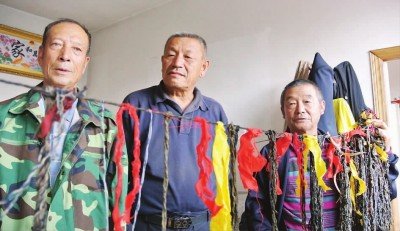Genealogical research yields diverse outcomes

The descendants of the Shi family showed the “children’s ropes” of the Manchus.
Family trees are to a family what history is to a nation and what chorography is to a region. All these forms of study are important for the Chinese nation.
In recent years, genealogy research -family trees in particular-has increasingly been used in both historical and cultural studies as well as contemporary compilation and editing work.
Institutions such as the Shanghai Library have been furthering their efforts to collect family trees and open up digital resources in batches. Genealogy has been widely used in research relating to social history, migration history, populations and the cultures of ethnic minorities. In recent years, some scholars have carried out studies of Huizhou family trees and social changes over the last millennium, the study of the Han ethnic migrant family trees in the southwestern frontier, and the collection of Tunpu family trees in central Guizhou Province.
Take the southwest region, which had a complex migration history, for example: In the Ming and Qing dynasties, the Central Plains were plagued with wars. Migrants from many other provinces moved to the Bashu regions (including Sichuan Province, Chongqing City, the south of Shaanxi Province and the west of Hubei Province), leaving a large amount of valuable folk literature in Sichuan Province, including family trees. This historical data fueled the study of social changes in the Sichuan area during the Ming and Qing dynasties. Chen Shisong, a research fellow from the Sichuan Academy of Social Sciences, has focused on the social changes during the Ming and Qing dynasties. He helped establish the Western Hakka Documentary Center in 2017 to collect and collate folk literature scattered across the area formerly known as Bashu.
In the vast collections of Chinese national genealogy, there are rich stories of family lines relating to minorities. These family trees includ e not only Han family lines, but also research on ethnic minorities, comprising a precious aspect of traditional Chinese culture.
In recent years, various local academic circles have started or completed a series of research works into familial lines relating to minorities. For example, “Collation and Research of the Northern Ethnic Minorities Genealogy,” a key project financed by the National Social Science Fund of China (NSSFC) and led by Wang Huabei, an associate librarian from the Ethnic Library of China, was completed in 2017. “Collation and Research of the South Ethnic Minorities Genealogy,” another major project of the NSSFC, chaired by Chen Zhiping, a professor from Xiamen University, is in progress.
Among the genealogy collections of ethnic minorities in China, Manchu family trees are among the most common and have always been valued by researchers in related fields. The Femanju Genealogy Collection, published by the People’s Publishing House in 2017, was well received in academic circles. The book has a complete compilation of selected femanju genealogy studies, many of which were revealed to the public for the first time. Femanju, the Manchu language for “Old Manchuria,” generally refers to the Jurchens who were enlisted in the banner system during Nurhaci’s reign. The editor-in-chief of the book, Lü Ping, dean of the Manchu Culture Research Institute at Changchun Normal University, said this compilation not only preserved Manchu folk materials, but also was designed to be more accessible to the general public, showing diverse cultures of ethnic minorities.
Qian Maowei, director of the Institute of History at Ningbo University, has long devoted himself to the study of historiography. He said that there are some new trends worth noting in contemporary genealogy compilation.
For example, research has shifted from the countryside to the cities; large scale genealogy (clan genealogy) and small genealogy (direct-line family trees within a century) coexist; genealogy has been extended from kinship to fellowship and families of the same surname are included in one family tree; electronic versions have emerged in addition to traditional paper family trees; genealogy became products so that people could participate in the compilation by filling in blanks in family trees online.
With regard to the social significance of the contemporary compilation of family trees, Qian said that recording a history of families could enrich the history of the nation. At the same time, family trees can help construct family culture, benefiting a great many. From the perspective of public history, gathering information for a family tree is a symbol of a family’s self-reliance. It is a way for the public to be a part of contemporary history.
